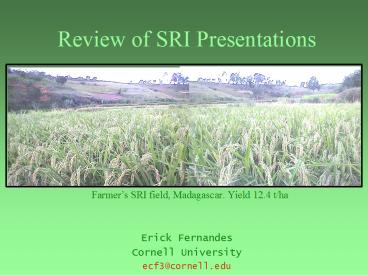Review of SRI Presentations - PowerPoint PPT Presentation
1 / 16
Title:
Review of SRI Presentations
Description:
With the exception of Madagascar, all other country reports are based on less ... Madagascar reports 'super yields' ranging from 17-23 t/ha relative to a national ... – PowerPoint PPT presentation
Number of Views:39
Avg rating:3.0/5.0
Title: Review of SRI Presentations
1
Review of SRI Presentations
Farmers SRI field, Madagascar. Yield 12.4 t/ha
- Erick Fernandes
- Cornell University
- ecf3_at_cornell.edu
2
Country Presentations
- 17 Country presentations
- Africa 3
- Asia 4
- S.E. Asia 7
- Americas 3
- With the exception of Madagascar, all other
country reports are based on less than 3 years of
data
3
Elements of SRI
- Careful transplanting of young seedlings
- (8-15 days)
- 1 or 2 seedlings per hill
- Alternating flooding and drying during vegetative
phase - Weeding and aeration
- Compost application
4
Total Factor Productivity
- Yields
- Labor
- Soils Roots
- Water
- Seeds
- Food quality
- Environmental benefits
5
Yields
- ¾ of studies confirm a significant yield
advantage in SRI vs conventional rice - For yields below 8 t/ha, yield increases due to
SRI were between 10-50. - Madagascar reports super yields ranging from
17-23 t/ha relative to a national average of t/ha - Madagascar data show 55 fertile tillers (70
required for very high yields) - Yield increases are most frequently observed on
farmers fields rather than on station
6
(No Transcript)
7
Yields II
- Although SRI results in increased yields for both
traditional and improved varieties, several
studies reported that some varieties respond
better to SRI than others. - 120-140 day varieties may respond best to SRI.
Very short or long duration varieties appear to
respond less. - Although suggested spacings for SRI vary between
25x25 cm to 35x35 cm, high yields (13 t/ha) have
also been reported at 45x45 cm. There is most
likely a significant interaction between variety
and spacing.
8
Labor
- Most studies report that SRI is more labor
demanding than conventional rice. (Three studies
reported that SRI required less labor). - Extra labor components land preparation, careful
planting of small seedlings, water and weed
management)
9
Soils Roots
- Effect of soil texture is still uncertain
- It is hypothesized that soil biological factors
are very important for SRI synergy. - Only 3 studies looked at root volume and root
activity or soil microbial dynamics. - Relatively little detailed soil data is
available. Important for nutrient budgets as
yields and nutrient harvests increases.
10
Compost Pits
- Crop residues
- Cattle manure urine
- Legume prunings
- Grass clippings
End of cropping season
Start of cropping season
11
SRI Plants
Traditional Rice
12
Water
- Flooding and draining of water requires good
access to and control of water - A few studies carried out detailed measurements
and report significant water savings relative to
conventionally flooded rice. - Weed pressure increases with draining and wide
spacings. - In one study, soil drying and cracking yielded
less than continuously moist soil.
13
Seeds
- Most studies reported a significant saving in the
amount of seed used to establish the rice field.
14
Food Environmental Impacts
- Fewer chemical and pesticide inputs can translate
into healthier food - Alternate flooding and draining can reduce CH4
emissions but result in significant increases in
NOx emissions. The effect of nitrous oxide is
35x greater than CH4.
15
Issues to Consider
- Better descriptions of the experiments
- Who is doing what? Metadata
- Where (georeferenced data sets)
- To tap into other databases (soils, vegetation)
- Replication of field trials (on farm, on station)
to get a better handle of variability observed - Socioeconomic studies to better characterize
tradeoffs
16
Issues to Consider II
- What is special about the sites where we observe
SRI yields 10 t/ha? - Soils, long-term management, soil biology?
- Should we have a standard experiment that is
conducted at selected sites across the regions?































